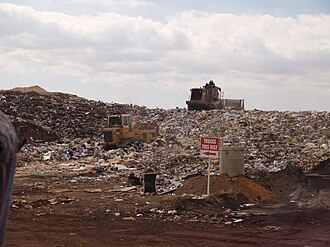Hygienic Issues of Solid Wastes
Wastes[edit | edit source]
The term solid wastes is defined as all forms of putrescible (i.e. liable to decay) and non-putrescible wastes, including garbage, rubbish, refuse, residential ashes, industrial wastes, demolition waste and all other materials and substances, which are accumulated in any public or private residence or commercial, business or industrial establishment.
Special wastes on the other hand, are all solid waste that require special preparation and special handling due to their large size or volume, dustiness or other unique features. Examples include tires, batteries, used motor oil, waste from health facilities, discarded or abandoned vehicles, discarded home or industrial appliances, discarded furniture, large dead animals.
The composition of waste varies by the type of neighborhood. Health hazards of solid waste depend on its composition, way of collection, transport, and final disposal.
Solid Waste Disposal[edit | edit source]
Landfills[edit | edit source]
In the Czech Republic, solid waste is most commonly transported to landfills. It is the simplest but not the best solution. Inflammable material in landfills is prone to self-ignition and a burning dump pollutes the environment by smoke and smells.
Landfills are a favorable environment for breeding of rodents (mice, rats) and insects (flies), especially where organic waste accumulates (i.e. waste from households and catering facilities). Rodents and flying insects are biological vectors of various diseases or transmit diseases passively. In European conditions, insects transmit mostly intestinal and pyogenic skin infections. Flies can also passively transmit viruses and parasites. It has been repeatedly observed that the flying range of flies may reach even several kilometers if the wind is favorable. The flying range of flies usually does not exceed 1 km, therefore a 1 km distance between a new landfill and the nearest settlement is acceptable. Rodents can transmit the same pathogens as insects; in addition, they are a natural reservoir of diseases such as leptospirosis, brucellosis and tularemia. Depositing wastes in landfills in oblique layers (not horizontal ones over large areas), can result in periodic desinsection and deratisation, and timely recultivation of the landfill which can limit rodents and insect breeding.
The location of future landfills must be carefully selected considering potential surface and ground water pollution. Dumps must not be located in flood areas or in areas considered as a potential future location of drinking water source.
Other Methods[edit | edit source]
Other methods include composting, industrial fermentation or incineration in conventional or high temperature incinerators. Both types of incineration require at least 2-step emission cleaning. Solid waste from agriculture, especially large-scale poultry and pig production waste may be processed by drying.
Recycling is an increasingly important way of waste disposal. It is the process of transforming or re-manufacturing materials into materials for use other than landfill disposal or incineration. Recycling includes composting of source-separated organics but not composting of mixed waste. Recyclable materials are the materials which have passed through their originally intended usage, have use or value as a commercial commodity, and are intentionally separated from solid waste by their original consumer for collection for the purpose of reuse, reprocessing or remanufacture. Examples include paper, cardboard, metal, aluminum, glass, plastic, and used motor oil.
Industrial solid toxic waste should be chemically neutralized and/or deposited in secluded toxic waste sites. The disposal of soluble toxic waste needs a special care to avoid the contamination of underground or surface water and soil pollution.
Links[edit | edit source]
Bibliography[edit | edit source]
- BENCKO, Vladimir, et al. Hygiene and Epidemiology : Selected Chapters. 2nd edition. Prague. 2008. ISBN 80-246-0793-X.


